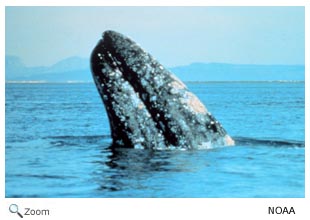Eschrichtiidae - gray whale
 There is one species of baleen whale in this family, the gray whale. Gray whales live in pods of 3-12 individuals. They are found in northern Pacific waters and are 45-50 feet in length and weigh 30-40 tons. Gray whales are gray and have 2-5 throat furrows. The furrows allow the gray whale to expand its throat when it is taking in water. There is one species of baleen whale in this family, the gray whale. Gray whales live in pods of 3-12 individuals. They are found in northern Pacific waters and are 45-50 feet in length and weigh 30-40 tons. Gray whales are gray and have 2-5 throat furrows. The furrows allow the gray whale to expand its throat when it is taking in water.
Gray whales have long, narrow heads; slightly arched upper jaws; and small dorsal humps on their backs. Gray whales are usually covered with barnacles and whale lice, except for on their right sides. They don't have barnacles and lice on their right sides because they scrape along the ocean floor on their right side when they feeding and any barnacles and whlae lice get scaped offscraped off!
Gray whales are filter feeders. They take in large amounts of water and filter out small crustaceans, plankton, mollusks, and small fish through their baleen. They feed in cold Arctic waters in the summer months. In the fall, gray whales migrates from the Arctic to their breeding grounds off the coast of Baja, Mexico and off the Korean coast. It is a round trip migration of 10,000-14,000 miles!
World Status Key
 Least Concern Least Concern  Near Threatened Near Threatened  Vulnerable Vulnerable  Endangered Endangered  Critically Endangered Critically Endangered  Extinct Wild Extinct Wild  Extinct Extinct
Status taken from ICUN Redlist. If no status is listed, there is not enough data to establish status, or there is no status data for the species.
US Status Key
 Threatened in US Threatened in US  Threatened in NH Threatened in NH  Endangered in US Endangered in US  Endangered in NH Endangered in NH  Introduced Introduced
Status taken from US Fish and Wildlife and NH Fish and Game
New Hampshire Species |
|
North/Central American Species |
| None |
|
Gray Whale - Eschrichtius robustus  |
Additional Information Resource Key
 Profile Profile  Photos Photos  Video Video  Audio Audio  Interactive Interactive
Gray Whale - Eschrichtius robustus      
The gray whale can grow to be up to 50 feet in length.
Source: Arkive Intended Audience: General Reading Level: Middle School
|

